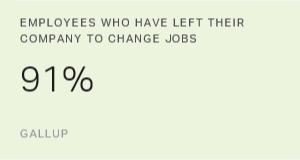Story Highlights
- Well-being includes five key elements -- not just physical
- Support of well-being must be embedded in a company's culture
- Managers play a key role in promoting employee well-being
When it comes to company wellness programs, for too long the prevailing belief has been "If you build it, employees will come."
This approach has led companies to spend $50 to $150 per employee per year on conventional programs that target physical health -- or an estimated $6 billion per year for the wellness industry overall -- according to studies by the RAND Corporation. However, Gallup has found that only 24% of employees at companies that offer a wellness program actually participate in it. What's more, only 12% of employees strongly agree that they have substantially higher overall well-being because of their employer.
Instead, a majority of employees believe their job is a detriment to their ability to achieve higher well-being. Given the great financial investment and concerted effort to take care of their employees, where are companies going wrong?
Through Gallup's research and experience, we've identified three key areas that either support or derail even the best of intentions:
- how your company defines well-being
- how your company culture supports well-being
- the role your managers play in promoting well-being
Let's look at these three areas more closely.
How Your Company Defines Well-Being
When thinking about well-being, too many companies focus primarily on physical health and fail to address the whole person -- which is why so many well-intentioned programs fall short. To have a positive impact on employees' well-being, companies must move beyond a sole emphasis on physical wellness to embrace all the elements that enable employees to live a thriving life.
Those elements encompass how people experience their lives and can be considered the currency of a life that matters. They're also the crucial elements that help determine whether you're getting the best out of your employees every day.
The Gallup-Healthways Well-Being 5Gallup and Healthways have developed a comprehensive, definitive source of well-being measurement, the Gallup-Healthways Well-Being 5. This scientific survey instrument and reporting experience measures, tracks, and reports on the well-being of individuals and organizations. The five essential elements of well-being are:
|
It's important to note that these five elements are interdependent. If people are struggling in any one of these elements, it damages their well-being and wears on their daily life. For example, consider the effects of not liking what you do each day (Purpose) and the impact that would have on your ability to maintain strong relationships (Social) or commit to eating well, exercising and getting enough rest (Physical). Similarly, money woes (Financial) can drain you physically while also perhaps undermining your desire to participate in volunteer or charitable activities (Community).
When you examine your company's current investment in wellness, does it focus on health and wellness alone, or does it encompass the other key elements that influence how your employees experience their lives? Developing thriving employees requires taking a whole-person approach. After all, employees bring every aspect of themselves to work each day.
Expanding your well-being approach to encompass all five well-being elements will pay dividends by helping your company improve the bottom line and outperform competitors. Gallup's analysis shows that adults who are thriving in all five elements report 41% fewer unhealthy days, are 65% less likely to be involved in a workplace accident, and are 81% less likely to look for a new employer, for example, than adults who are thriving in just Physical well-being alone.
How Your Company Culture Supports Well-Being
Employees' perception of organizational support -- the extent to which they believe their company values their contribution and cares about their well-being -- has a significant influence on their likelihood to participate in a well-being program. What shapes your employees' current perception of well-being? And what are the potential barriers that prevent them from participating in a well-being program?
Your company can offer a stress management course, but if employees can't participate because of structural or cultural barriers, it's not going to go very far toward helping them reduce their stress. Well-being must be built into the fabric of the organization so employees don't have to sacrifice performance or take personal risks to improve theirs.
Businesses that take a holistic view of well-being recognize that their organizational identity -- why they exist, how they are known in the market and how they live and work -- influences an employee's ability to achieve higher well-being.
A comprehensive approach requires:
- integrating well-being into your beliefs, behaviors and systems
- managers who can engage their work teams and create a local environment that supports well-being
- employees who take responsibility for improving their own well-being
Companies that develop successful well-being programs recognize they must do more than just offer a program; they must create an organizational culture that allows employees to actively participate in it. Scheduling a financial education workshop on retirement planning might boost employees' Financial well-being, but only if leaders and managers construct pathways that allow employees to attend -- by canceling a regular meeting in its place, for example, or by counting the time as employee development.
Creating a culture of well-being also requires companies to modify their structure and policies to facilitate well-being. One hospital listened to why its staff were not participating in its myriad on-site well-being initiatives and opened an on-site childcare facility in response. This move met the needs of its employees, enhanced their well-being and engagement, and improved employee engagement and morale.
The Role Your Managers Play in Supporting Well-Being
Managers play a key role in improving employee well-being by modeling how they improve their own well-being -- and by helping employees to improve their well-being too. Gallup has found that direct reports of supervisors with thriving well-being are 15% more likely to be thriving six months later. At your company, do your managers carve out time to take vacation, go to the gym or attend their children's school events? If managers don't do these sorts of things, employees will feel they can't either.
At Gallup, we know one of the most important decisions companies make when engaging employees is simply who they name manager, and this is true for encouraging well-being as well. Managers account for at least 70% of variance in employee engagement scores across business units, and engaged employees are 28% more likely to participate in a wellness program offered by their company than are average employees. Engaged employees also are seven to nine times more comfortable talking about their well-being with their supervisor, and those conversations are crucial in motivating and mentoring employees.
Our experience shows that managers play a key role in promoting well-being by:
- creating an environment where employees feel they're supported and in control of their well-being
- operationalizing company initiatives and removing local barriers that could disrupt the successful launch of well-being programs
- pointing employees toward well-being resources and providing opportunities to use these resources in their roles
- seeing the growth of each employee as an end in itself instead of a means to an end
What's good for employees is good for your business; taking care of employees is in your company's financial interest. When employees feel good about their lives, they will be fully engaged at work and bring their best selves to work every day. By creating a culture that allows employees to thrive across the five well-being elements, organizations gain a competitive advantage from employees' maximized performance, reduced turnover and enhanced engagement.


